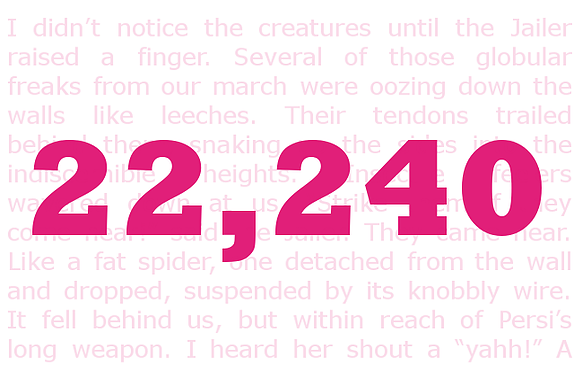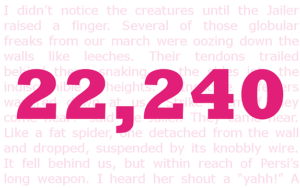
In August, over 31 days, I wrote new 22,240 words. I also:
- wrote three critiques,
- participated in three online writing communities,
- edited a lot of my own stuff,
- commissioned cover art,
- sent work out to beta readers,
- set up Mailchimp for eventual email lists,
- wrote 31 blog posts,
- and began concept work on what will likely be my next novel.
I did not ship (publish) any titles, which is slightly disappointing, but the word count helps balance it out. If September finishes and I still don’t have material out there, it’ll be time to really furrow the brows and evaluate what’s wrong.
Lesson 1: Episodic writing is not easy
When I started this pursuit, I figured it’d be simple. If I wrote a 50,000 word piece, I could carve it up into 12,500 word chunks. Polish the endings and beginnings a touch and then serialize the release as episodes. However, two things have given me pause. First, there’s a lot of advice out there about making sure any standalone piece, no matter how short, is in fact a complete story. Lest a Reader feel cheated or like you’ve purposely gamed them into buy/downloading the next part. Second, when I actually tried to write a piece with the longer story in mind, but aimed for a 10-12K episode, my own interest and love of the story suffered. That bled into the writing, and I ended up scrapping it.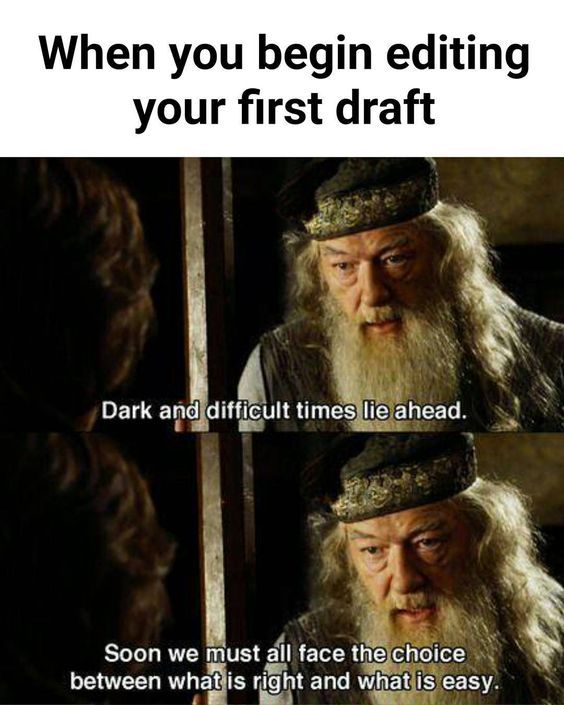
Without actually testing, I don’t know if the idea of making each episode standalone is truly what the market needs or wants. Instinct and general common sense tells me that I should err on the side of standalone episodes. All this means is that the characters must have a discrete goal within each episode. Each episode should have a classic beginning, middle and end (however one likes to structure it). Cliffhangers, leads into the next episode, and meta-goals and arcs are all permissible and arguably necessary, but not sufficient to successfully create an episodic, season-based series of books. Anyone in TV-land probably already knows this intimately, and here I am catching up. (This article more eloquently tackles the problem.)
The debate puts a bit of wrench into some initial plans. My novel, THE CHILDSEEKER’S WAR, is something like 67,000 words long, and I’d hoped to release it in chunks. Now I’m not so sure about that. I found some nice plot division areas but am pretty sure they do not pass the ‘self-contained’ rules outlined above. I’d like to find a solution other than simply releasing it all at once (that’s a long, hard road for the self-published author, by all accounts), so stay tuned. I may have to rewrite the four chunks I have into self contained pieces. Also not desirable, since I’ve been labouring on the story for more than a year now… but I may not have much choice. Stay tuned!
Lesson 2: Use CritiqueCircle.com
I loved this site back when I first started seriously cranking out fiction. There was a lull, then I came back this month. Within a few weeks, I was happily signing up and paying for their 2-year premium subscription (costs about $100 CAD with today’s exchange rate). Money well spent.For those not in know the core function of CritiqueCircle (CC) is to give and get feedback on your stories. Roughly, for every two-three crits you provide you’re allowed to submit your own story, which can receive well over three crits back (I think my pieces had 5 or 6, and I’ve seen some submissions get over 15).
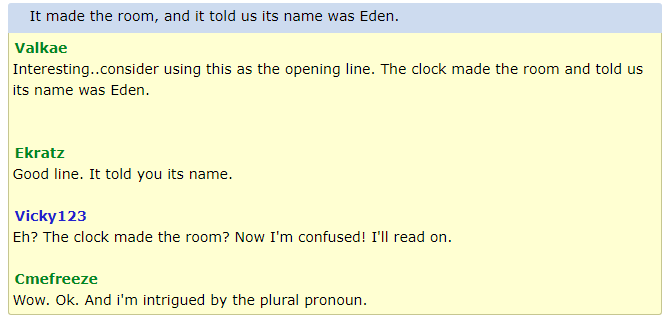
The people providing feedback are generally quite talented writers or editors themselves (you can set criteria to filter out newer members). The system and design of the site is actually much more functional than pretty (it would not translate into a mobile app very well), but once you get used to it, the value it provides is insane.
I think of it as access to wonderful, thoughtful beta-readers—the only “cost” is participating as a beta-reader yourself (which, in turn, helps you improve). Most crits are in-line, and you can view multiple crits together, so it’s very easy to spot places where people are getting hung up, parts everyone likes, etc. The picture above is an example of this.
Plus, there’s a bevy of other very thoughtful tools built into the experience that have very clearly been designed by writers and savvy web engineers. I can’t think of any excuse for a writer in this day and age to not be making use of this place.
Lesson 3: I am a burst writer
Meaning, I tend to produce words in explosive chunks versus a steady daily stream. I made a chart of my word count in August. I was shocked to see the number of days where I didn’t write. I knew they existed, I blogged about them! But I didn’t realize I had so many empty stretches.This is contrasted by sudden towers of words. On the chart, they’re all dwarfed by the skyscraper of writing I did early in the month.
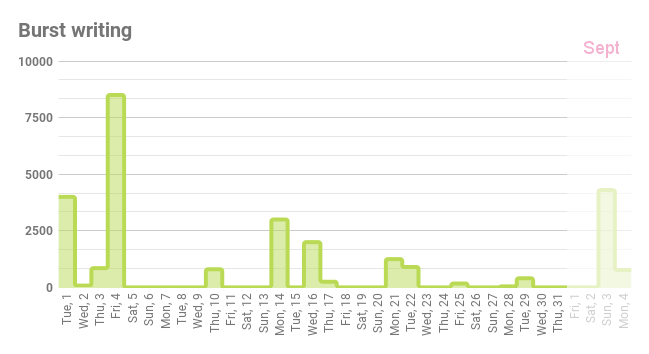
On average, it’s about 720 words/day. I write at about 800 words per hour when I’m zoned in, so this reflects some 28 hours worth of writing. Given my part time goal was to commit 20-30 hours per month (seems reasonable for a part-time job mentality), I’d say I did quite well, considering I did much more than only write.
Point is, it’s no use stressing about failing to march to a daily routine. Life happens, there are commitments and creative droughts. The approach of “think in months, plan in weeks,” is shaping up to be an okay approach, at least for month one.
Advice on beating the block
When I’m bored or uninspired, it’s hard to write. Many believe you should not force the writing when bored or uninspired, as the Reader can always tell when the Author is phoning it in. I agree to some extent. This month, three things helped me break through the barrier.
1) Forcing it. Yep! The rule here is that it’s allowed to be bad, and the editing will save it later. If I’ve got a stretch of uninterrupted time in front of me that should be used to write, and I don’t feel like it, I try to do it anyway. More often than not, once the fingers start moving they can survive on their own momentum for a surprisingly long time. It’s not fun, at least to start. I kind of hate it. But this is discipline vs motivation (discipline always wins). I’ll find myself having fun after the momentum has taken over.
2) Plotting. I am not a skilled disciplinarian, despite my conviction in its power. So, sometimes I will break and refuse to force-write. Or I’ll find an excuse (they’re in high supply)! The next best thing for me is to start plotting. Maybe I’ll revamp the piece that’s giving me trouble, or let my brain explore something else entirely. Usually I’ll write semi-intelligible, stream-of-consciousnesses notes to myself in the process. 1,300 words of this helped break the spell at the end of the month. They don’t count towards the logged 22K, but they gave birth to the 4.3K on Sept 3 and the current 760 or so on the 4th.
3) Reading. I titled one blog: ‘When words won’t come out, put words in.’ Most Writers agree that we need to spend a good chunk of time reading. Not only for ideas, but to put ourselves in the mindspace of our audiences. This particular month, Terry Prachett’s The Colour of Magic re-introduced me to the skillful use of third-omnipresent POV—something I’ve not touched in a long time. I realized it was likely well suited for the new novel I’m cooking up. This will grant me an easier time in starting the new piece, whenever that happens, which will result (hopefully) in fewer snags and more words.
Next month I hope to have more insight on the actual publishing process. I’ve done it before and have gathered all my tools, and I doubt the KDP has changed drastically, but you never know!

